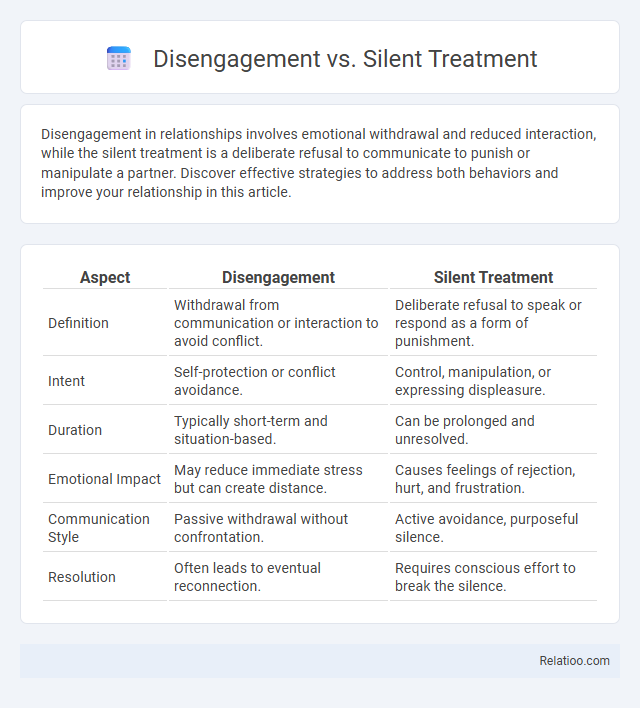Disengagement in relationships involves emotional withdrawal and reduced interaction, while the silent treatment is a deliberate refusal to communicate to punish or manipulate a partner. Discover effective strategies to address both behaviors and improve your relationship in this article.
Table of Comparison
| Aspect | Disengagement | Silent Treatment |
|---|---|---|
| Definition | Withdrawal from communication or interaction to avoid conflict. | Deliberate refusal to speak or respond as a form of punishment. |
| Intent | Self-protection or conflict avoidance. | Control, manipulation, or expressing displeasure. |
| Duration | Typically short-term and situation-based. | Can be prolonged and unresolved. |
| Emotional Impact | May reduce immediate stress but can create distance. | Causes feelings of rejection, hurt, and frustration. |
| Communication Style | Passive withdrawal without confrontation. | Active avoidance, purposeful silence. |
| Resolution | Often leads to eventual reconnection. | Requires conscious effort to break the silence. |
Understanding Disengagement and Silent Treatment
Disengagement involves emotional withdrawal and reduced communication without overt hostility, whereas silent treatment is a deliberate act of refusing to communicate as a form of punishment or control. Understanding disengagement requires recognizing its subtle signs such as decreased responsiveness and lack of participation, while silent treatment is characterized by intentional silence aimed at eliciting a reaction. Both behaviors disrupt healthy communication but differ in motivation and expression.
Key Differences Between Disengagement and Silent Treatment
The key difference between disengagement and silent treatment lies in intent and communication style; disengagement refers to a gradual withdrawal from interaction due to lack of interest or emotional investment, while silent treatment is a purposeful, punitive withholding of communication to manipulate or punish. Disengagement often manifests through reduced responsiveness and emotional detachment without deliberate hostility, whereas silent treatment is characterized by deliberate silence intended to cause discomfort or assert control. Understanding these distinctions is crucial in addressing relationship dynamics and fostering healthy communication.
Psychological Roots of Both Behaviors
Disengagement involves emotional withdrawal as a coping mechanism to avoid conflict or stress, often rooted in fear of vulnerability or past trauma. Silent treatment stems from a desire to control or punish, linked to feelings of insecurity, powerlessness, or unresolved anger. Both behaviors reflect underlying psychological defense mechanisms that hinder effective communication and emotional connection.
Impact on Personal Relationships
Disengagement in personal relationships often leads to emotional withdrawal, reducing meaningful communication and fostering feelings of neglect. The silent treatment exacerbates conflicts by creating barriers to resolution, resulting in increased resentment, mistrust, and emotional distance between partners. Both behaviors deteriorate relationship quality by undermining intimacy and preventing effective conflict management, ultimately risking long-term relational damage.
Recognizing the Signs of Disengagement
Recognizing the signs of disengagement involves noticing lack of participation, reduced communication, and withdrawal from conversations or tasks. Silent treatment specifically manifests as deliberate refusal to speak or acknowledge others, while disengagement encompasses broader emotional or physical detachment. Identifying these behaviors early helps address underlying issues in relationships or workplaces.
Identifying Silent Treatment in Communication
Silent treatment in communication is characterized by deliberate withdrawal and refusal to respond, which differs from general disengagement that may arise from distraction or lack of interest without intent to hurt. Identifying silent treatment involves recognizing patterns of prolonged, purposeful non-responsiveness aimed at punishing or controlling Your partner. Understanding these distinctions helps address the underlying emotional issues and improves conflict resolution strategies.
Emotional Consequences for Individuals
Emotional consequences of disengagement often include feelings of confusion and emotional neglect, as individuals sense a withdrawal of attention without clear communication. In contrast, the silent treatment intensifies emotional distress by deliberately withholding dialogue, leading to increased anxiety, frustration, and diminished self-worth. Your emotional well-being can be significantly impacted by these behaviors, as both create barriers to resolution and healthy connection.
Healthy Alternatives to Disengagement and Silent Treatment
Disengagement and silent treatment often lead to communication breakdowns and emotional distance in relationships, making it crucial to adopt healthy alternatives such as open dialogue and active listening. Techniques like expressing feelings honestly, setting boundaries respectfully, and seeking mediation can foster mutual understanding and emotional connection. Prioritizing empathy and consistent communication helps prevent misunderstandings and rebuild trust more effectively than withdrawal or ignoring issues.
Steps to Address and Resolve Communication Barriers
Addressing communication barriers requires recognizing the distinct behaviors of disengagement, silent treatment, and avoidance, each impacting relationship dynamics differently. Begin by fostering open dialogue that encourages emotional expression without judgment, helping to break patterns of withdrawal or silence. Implement consistent active listening and validate feelings to rebuild trust, followed by setting clear boundaries and agreements to prevent recurring communication breakdowns.
Building Stronger Connections Through Open Dialogue
Disengagement, silent treatment, and disengagement are distinct communication challenges that hinder relationship growth, with disengagement involving emotional withdrawal, silent treatment characterized by intentional refusal to communicate, and disengagement reflecting overall disinterest. Building stronger connections requires recognizing these patterns and fostering open dialogue that encourages vulnerability and active listening. Prioritizing transparency and empathy in conversations enhances trust and resolves conflicts effectively, promoting deeper emotional bonds.

Infographic: Disengagement vs Silent Treatment
 relatioo.com
relatioo.com